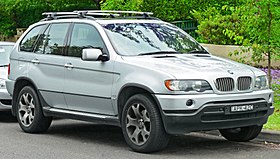BMW X5 (E53)
| BMW X5 (E53) | |
|---|---|
 |
|
| Overview | |
| Manufacturer | BMW |
| Production | 1 September 1999 – 22 September 2006 |
| Assembly | United States: Greer, South Carolina (BMW US Mfg. Comp.) Mexico: Toluca (BMW de México) |
| Designer | Christopher Chapman; Chris Bangle (1996) |
| Body and chassis | |
| Class | European: J-segment American: Mid-size luxury crossover SUV |
| Related | BMW E39 |
| Powertrain | |
| Engine | petrol straight-6 petrol V8 diesel straight-6 |
| Transmission |
5-speed automatic |
| Dimensions | |
| Wheelbase | 111.0 in (2,819 mm) |
| Length | 183.7 in (4,666 mm) |
| Width | 73.7 in (1,872 mm) |
| Height | 1999-03 V8: 67.2 in (1,707 mm) 2001-03 I6: 67.5 in (1,714 mm) 2004-06 V8: 69.0 in (1,753 mm) 2004-06 I6: 69.3 in (1,760 mm) |
| Chronology | |
| Successor | BMW X5 (E70) |
5-speed automatic
5-speed manual
6-speed automatic
The BMW E53 is the first-generation BMW X5 mid-sized luxury crossover SUV. It was produced from 1999-2006 and was replaced by the BMW E70. The E53 was developed at a time when BMW still owned Land Rover and as such shares many components and designs with both the Land Rover Range Rover L322 model (specifically the Hill Descent System and Off Road Engine Management system) and the BMW E39 5-series (specifically engines and electronic systems). The entire in-car entertainment system (Radio Function, Navigation System, Television and Telecommunications systems) are shared with other BMWs and L322. As a result, the earlier X5 and L322 models can be easily upgraded with the newest BMW technologies.
The history of the X5 begins in 1994, when ideas began on a BMW sports utility vehicle after the acquisition of Land Rover. Eduard Walek was named project leader and chief engineer of the E53. Chris Chapman joined BMW Group's Designworks in California later and began working with Bangle in Munich on two full-scale clay models of the E53 for two months. By the autumn of 1996, design work was approved and the design basis for the X5 (E53) was defined, 35 months prior to production. After supplier and engineering involvement, the final design freeze was reached in the first half of 1997, with prototypes being tested from the second half of 1997. Design patents were filed on 10 June 1998 and 9 December 1998, being registered in the U.S. on 18 January 2000.
The takeover of Rover in 1994 proved to be very beneficial for BMW in the development of the X5. BMW engineers were able to look at and use Range Rover technology and parts in the development of the X5 - one such example would be hill-descent control. In many respects, the design of the X5 was influenced by its British counterpart; for example, the X5 got the two-piece tailgate straight from the Range Rover. Many parts and electronics were also taken directly from the E39 5 Series parts bin to save costs.
...
Wikipedia
